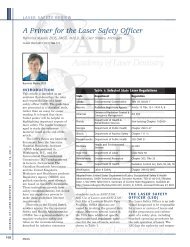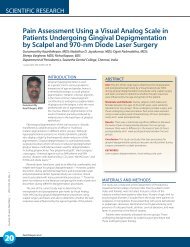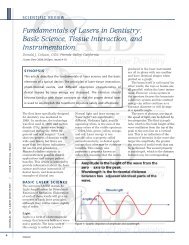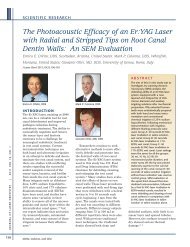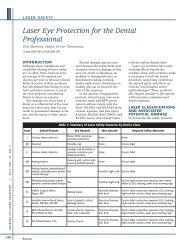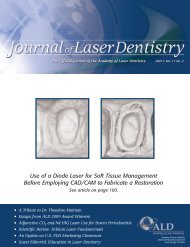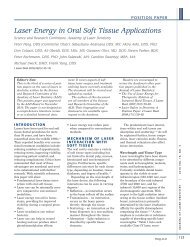Create successful ePaper yourself
Turn your PDF publications into a flip-book with our unique Google optimized e-Paper software.
C L I N I C A L R E V I E W A N D C A S E R E P O R T S<br />
Photobiomodulation: An Invaluable Tool for All<br />
Dental Specialties<br />
Gerald Ross, DDS, Alana Ross, BScH, Tottenham, Ontario, Canada<br />
J <strong>Laser</strong> Dent 2011;19(3):289-296<br />
I N T R O D U C T I O N<br />
Although low-level lasers are being<br />
used successfully in many dental<br />
clinics, the wide range <strong>of</strong> applications<br />
is still largely unknown to<br />
many practitioners, especially<br />
dental specialists. In these fields,<br />
there is the potential to see the<br />
most definitive results <strong>of</strong> what laser<br />
therapy can do to improve clinical<br />
outcomes and patient satisfaction.<br />
Photobiomodulation (PBM), also<br />
commonly referred to as low-level<br />
laser therapy (LLLT) or cold laser<br />
therapy, uses light energy to elicit<br />
biological responses from the cell<br />
and normalize cell function.<br />
Numerous studies have shown that<br />
PBM affects the mitochondria <strong>of</strong><br />
the cell, primarily cytochrome-c<br />
oxidase in the electron transfer<br />
chain and porphyrins on the cell<br />
membrane. 1-2 It has been proposed<br />
that when light photons are<br />
absorbed by these receptors, three<br />
events occur: stimulation <strong>of</strong> adenosine<br />
triphosphate (ATP) synthesis<br />
by activation <strong>of</strong> the electron transport<br />
chain; transient stimulation <strong>of</strong><br />
reactive oxygen species, which<br />
increases the conversion <strong>of</strong> adenosine<br />
diphosphate (ADP) to ATP;<br />
and a temporary release <strong>of</strong> nitric<br />
oxide from its binding site on<br />
cytochrome-c oxidase. These factors<br />
contribute to the clinical effects<br />
seen with PBM, including tissue<br />
repair, relief <strong>of</strong> inflammation and<br />
pain, and repair <strong>of</strong> nerve damage. 3<br />
Figure 1 depicts a flowchart<br />
showing these interactions.<br />
Studies have documented beneficial<br />
effects <strong>of</strong> PBM, such as<br />
stimulation <strong>of</strong> fibroblasts and<br />
osteoblasts, as well a reduction <strong>of</strong><br />
the depolarization <strong>of</strong> nerve fibers. 4-6<br />
From a clinical perspective, PBM<br />
<strong>of</strong>fers dental practitioners a nonin-<br />
Figure 1: Summary <strong>of</strong> the primary mechanisms <strong>of</strong> photobiomodulation<br />
vasive and nonthermal treatment<br />
modality that can be used as an<br />
adjunct to traditional therapies or<br />
as a therapeutic tool on its own. 7<br />
Examples <strong>of</strong> these clinical applications,<br />
which will be discussed below,<br />
include dental analgesia, treatment<br />
<strong>of</strong> dentin hypersensitivity, healing <strong>of</strong><br />
s<strong>of</strong>t tissue lesions, reduction <strong>of</strong> pain<br />
and swelling after surgical procedures,<br />
better integration <strong>of</strong> implants<br />
into bone, and faster movement <strong>of</strong><br />
teeth during orthodontic procedures.<br />
Determining the Appropriate<br />
Dose<br />
Treatment dose is probably the<br />
most important variable in laser<br />
treatment. Dose is measured in<br />
joules per square centimeter (J/cm 2 )<br />
and is a measure <strong>of</strong> the amount <strong>of</strong><br />
energy that is conducted into the<br />
tissue. Clinical effects <strong>of</strong> the laser,<br />
such as wound healing, pain relief,<br />
or muscle relaxation, are all sensitive<br />
to different irradiances or<br />
doses. An example <strong>of</strong> this is the<br />
stimulation <strong>of</strong> fibroblasts; a dose <strong>of</strong><br />
5 J/cm 2 will stimulate the cellular<br />
activity <strong>of</strong> fibroblasts, whereas<br />
higher doses inhibit cell viability<br />
and proliferation. 8 Thus, for wound<br />
healing, the clinician should ideally<br />
use a dose lower than 5 J/cm 2 .<br />
The biostimulatory and<br />
inhibitory effects <strong>of</strong> lasers are<br />
governed by the Arndt-Schultz<br />
Law, which indicates that weak<br />
stimuli will increase physiological<br />
processes and strong stimuli will<br />
inhibit physiological activity. A<br />
therapeutic window, which includes<br />
both biostimulatory and bioinhibitory<br />
effects, is evident and is<br />
the intended target for PBM treatments.<br />
A depiction <strong>of</strong> the law, based<br />
on Baxter, 9 is shown in Figure 2.<br />
Ross and Ross<br />
J O U R N A L O F L A S E R D E N T I S T R Y | 2 011 V O L . 19 , N O . 3<br />
289





